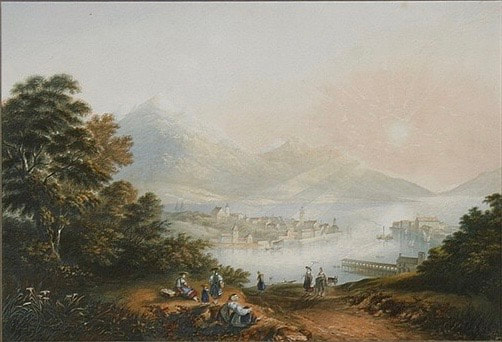Engravings
|
Research by Anne Matthews
|
 Lake Lucerne, Switzerland Lake Lucerne, Switzerland
|
Baxter, George 1804-1867
Lake Lucerne, Switzerland Acc No 122 Medium hand coloured engraving Size 25.4 x 38.1 cm (10 x 15 in) Date engraved June 1857 Donor Miss Emily Green 19 York Road, St Annes Dated donated 21 January 1952 Note: This was bequeathed with 15 framed watercolours including two by E Myers and two by E Tucker Baxter, George 1804-1867 North Italian Lakes Acc No 124 Medium hand coloured engraving Size 26.7 x 38.1 cm (10.5 x 15) unknown acquisition method image not available at present time |
|
George Baxter was born on 31 July 1804 at 37 High Street, Lewes, Sussex, the second son of John Baxter (1781-1858), the printer publisher and bookseller who issued the popular illustrated ‘Baxter’ Bible, and Charlotte, nee Warner. He was one of six children. At 20 Baxter was illustrating books printed by his father but, aged 23, moved to London, to be apprenticed to Samuel Williams, a wood engraver.
In 1827 he married Mary Harrild, the daughter of Robert Harrild, a friend of his father’s, who was a manufacturer of printing machinery, and with his backing Baxter set up his own printing business. Baxter now began to experiment with his own methods of colour printing and published his first colour print, Butterflies, in 1829. In 1834 he achieved commercial success with two small vignettes published in Robert Mudie’s British Birds, followed by a number of colour prints which were used as frontispieces in books published by Mudie. His work was also widely used by the London Missionary Society. By 1835 Baxter had developed his method of colour printing sufficiently to apply for a patent: Patent No 6916 – Improvements in Producing Coloured Steel Plate, Copper Plates and other Impressions. This outlined the combined intaglio and relief process he would continue to use for the next 30 years and was the first viable alternative to the hand-coloured print. Following the renewal of his patent in 1849, which lasted another five years, he began to sell licences for the use of his printing process to other printing firms, who recognised the commercial potential of this method. Around the middle of the century ‘Baxter prints’ enjoyed great popularity, making coloured reproductions of paintings available to the masses. However, although he sold his work to several highborn clients, even attracting interest from the Royal family, especially Prince Albert who encouraged him to exhibit at the Great Exhibition of 1851 (Gems of the Great Exhibition), he had little business sense and did not profit greatly from his invention. This was partly due to the fact that having created a process whereby colour could be achieved at a relatively low price, he then encountered competition from cheap, coloured lithographs. But he was also renowned for his perfectionism and it has been suggested that this prevented him from completing many of his commissioned works on time. In 1860 Baxter held a sale of all his stock and equipment, most of which was not sold. His plates and blocks were bought by the printer, Vincent Brookes, who later republished some of Baxter’s images. Eventually, despite his technical excellence, Baxter became bankrupt in 1865. Baxter died in January 1867 after being struck by a horse drawn omnibus. Although the licensees continued to use the Baxter Patented Process for a short time after his death, the process soon died out due to the introduction of chromolithography, which was faster and cheaper to produce. Baxter’s home and workshop from 1844-1860 at 11 Northampton Square in Clerkenwell, London, is marked by a plaque on the modern building now at that address. |
REFERENCES
The New Baxter Society George Baxter, British engraver and printer, Encyclopedia Britannica, Baxter, George, The Oxford Dictionary of Art and Artists, Oxford Index Baxter, George (1804-1867), printmaker, Grove Art Online Baxter, George (1804-1867), colour printer, Oxford Dictionary of National Biography Wikipedia www.alamy.com (images of The Gems of the Great Exhibition) www.metmuseum.org |
